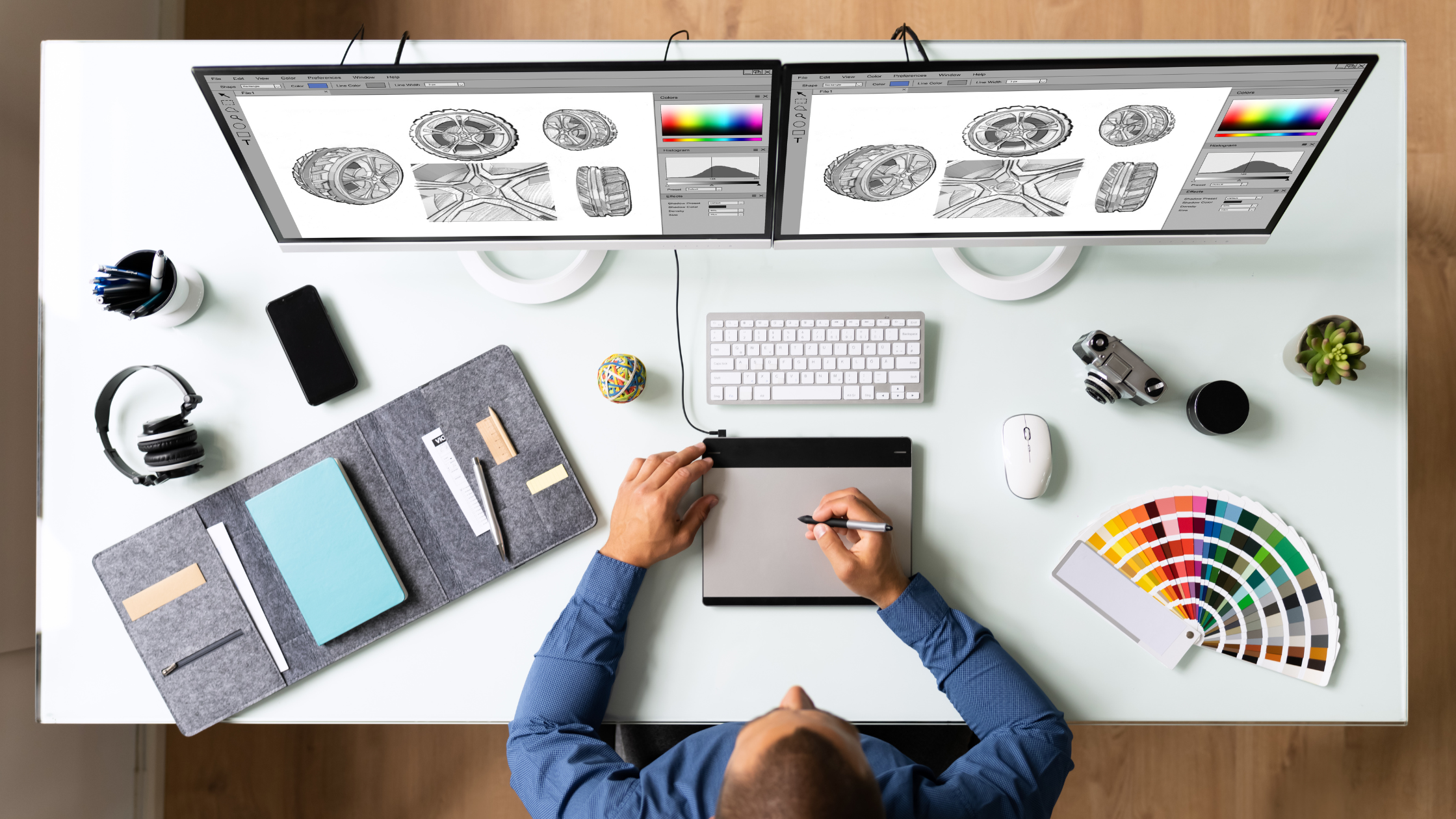Web Design Trends in 2024
Your website is an important aspect of your marketing strategy — or it should be. Following the newest developments in web design is the most effective way to make sure your website stands out from the crowd as technology advances.
Web designers must always adapt to new opportunities and problems since web design and its best practices are dynamic. In 2024, advances in AI and a number of web design trends have changed the way that websites are made and used.
The best method to make an impression on your audience through your website is to provide them with current and popular content. You must simultaneously deliver a clear message and demonstrate to them what your brand is all about.
Website Design Trends for 2024:
An essential component of any website design is the user experience (UX) design. Your website design needs to be both aesthetically beautiful and useful if you intend on attracting visitors.
1. Illustrative Design:
Illustrated web pages are starting to take the place of photographs in web design. The fact that illustrations often load more quickly and have smaller file sizes than photography is a major factor in their popularity for 2024. An increasing number of web designers and developers are searching for solutions to speed up web pages as a result of Google’s ongoing drive for fast load times through its Core Web Vitals page experience metrics.
In web design, illustrations can serve as an excellent way to illustrate ideas that a photo would be harder to explain. Effective use of illustrations can enhance the message of web pages that highlight a service or cause rather than a specific product.
Finally, creating a personalized, unique illustration that does not exist anywhere else on the internet can be an excellent method to attract consumers’ attention and imagination. Your brand will gain a great deal from investing the additional time and money in a superior, unique artwork as opposed to a repurposed stock image.
2. Interactive design and storytelling:
The popularity of interactive website features is growing, and in 2024, user experience animation will still be a key component of responsive web designs. Customers visit websites with dynamic and responsive elements for longer periods of time. Regretfully, putting such UX design trends into practice can be costly and time-consuming. More automated development procedures are something our web design team is hoping will happen in order to save expenses for clients who want special, interactive features on their websites.
3. Huge headlines/ titles that capture attention:
Users seem to have less time to spend on websites in our fast-paced environment. Because of this, design is changing to incorporate attention-grabbing headlines and succinct messages in an attempt to engage in viewers and shorten their conversion time. Similar to the minimalist technique, the larger heading tags are typically coupled with smaller sub-text copy if more information is required.
4. Micro Animations:
Even if little animations are nothing new in website design, we predict that in 2024, they will become more popular. Websites can be made to feel more alive by using subtle movements, which can leave an impression on visitors. Google is actually observing micro-animations that identify the most recent CWV metric, interaction to next paint (INP). This measures the amount of time a user spends waiting for a page’s next interaction to occur. Micro animations and designs can be an excellent way to draw the user’s attention to key elements of a website and emphasize them.
5. Neomorphism Design:
Neomorphism graphic design is based on web 2.0 skeuomorphism and flat design principles. Essentially, neomorphism creates a clean, minimalist visual style that is maintained throughout the design. It’s basically a monochromatic look that emphasizes color shifts and shadows. This can minimize the possibility of visual clutter while allowing the user’s attention to be focused on stuff that is vital.
Although this design is undoubtedly very visually appealing, because buttons and other elements lack contrast, it might cause problems with the user experience if not used properly. For this reason, a lot of UX professionals recommend on using this style. However, when used properly, neomorphism web design can result in a gorgeous appearance that is very crisp and clear. It appears that the neomorphism web design trend is expanding.
6. Cartoons Characters:
In 2024, illustrated figures will still be a popular choice for homepage designs. Characters that are specific to your website design give flexibility by being thoughtfully designed and placed to create a lasting impression. Who doesn’t adore a fantastic cartoon character, too? Lastly, this design can help with website load time since clear graphics frequently load more quickly than images.
7. Dark Mode:
User comfort and accessibility are given priority in Dark Mode and Low Light UX Design, which are emerging as major trends in web design for 2024. Particularly in low light, Dark Mode provides a visually pleasant and less straining alternative to conventional bright interfaces. Websites can lessen screen glare and improve readability by using contrast changes and darker color schemes. This is further enhanced by Low Light UX Design, which customizes user interfaces to different lighting conditions. To guarantee clarity and usefulness in low light conditions, interactive features, typography, and color contrast all need to be carefully considered. The combined goal of these developments is to produce digital experiences that are more approachable and inclusive.
8. Color Branding:
The multicolored branding appearance is another 2024 web design trend that we are captivated with. The majority of businesses are switching to a new style of website design where the color changes as the user navigates through the website and is branded according to the page or product. Based on color signals, this web design facilitates user navigation and creates subconscious associations with product or service sites.
9. Diagonal lines pushed by UX:
In 2024, UX-Driven Diagonal Lines will be a fundamental component of modern online design. These lines are not only visually appealing, but they also significantly improve user experience. The diagonal lines on a page help drive the user’s attention through it by adding a sense of direction and energy. Users may locate necessary information more easily because of its well-planned positioning, which also enhances navigation. Furthermore, diagonal lines have the ability to escape from strict grid systems, giving the design a contemporary and inventive vibe. But how they are implemented needs to be deliberate and well-thought out, constantly keeping in mind how they work with other components and enhance usability as a whole.
Diagonal line integration needs a profound grasp of user psychology and behavior. The lines must support the desired message and blend in with the content, according to designers. When utilized carefully, diagonal lines can provide a visually striking and easy-to-use website that makes an impact.
10. Scroll-Triggered Animations:
A webpage’s user navigation triggers the activation of dynamic visual effects known as scroll-triggered animations. Through the building of a more dynamic and immersive browsing experience, these interactive components improve user engagement. Designers can direct users through content, emphasize important information, and show activities in an aesthetically appealing way by carefully timing animations to match scrolling. Scroll-triggered animations provide an infinite amount of options for enhancing the depth and individuality of websites, ranging from modest transitions to intricate parallax effects. Use of these animations must be sparing, nevertheless, in order to prevent confusing consumers or impairing functionality.
11. Monochromic Design:
Monochromatic websites are a memorable trend that is gaining popularity, and we predict it to remain until 2024. This design can result in a minimal, clean look and let users’ attention be drawn to elements with striking color contrasts. Websites that are monochrome can be quite successful if your company prioritizes creating engagement with a compelling call to action.
Wrapping It Up:
To be modern and creative, designers must continue to be flexible. Designers can push creative boundaries by being aware of and using evolving trends, which helps their work stand out in a crowded market and connect with modern audiences.
In 2024, web design will have evolved to the point where designers are encouraged to try new things, embrace diversity, and push the envelope. Designers can create websites that not only fulfill practical requirements but also motivate consumers by remaining inquisitive and receptive to emerging trends.





